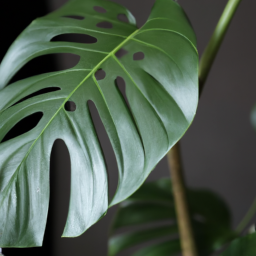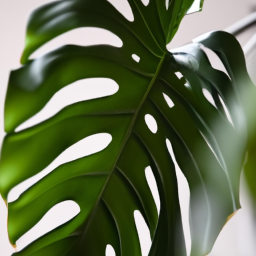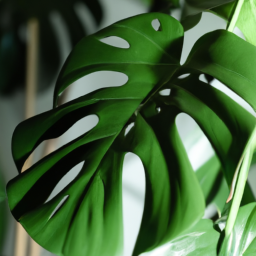
Are you considering adding a touch of greenery to your indoor space? If so, you may have come across the Monstera plant in your search for the perfect houseplant. But, is Monstera a good indoor plant? This is a common question among plant enthusiasts and beginners alike. In this blog post, we will explore the qualities of the Monstera plant and whether it is a suitable choice for your indoor environment. So, grab a cup of coffee, sit back, and let’s dive into the world of Monstera plants!
Benefits of Monstera as an Indoor Plant
When it comes to choosing the perfect indoor plant, the Monstera is a popular choice among plant enthusiasts for several reasons. Not only does it add a touch of elegance and beauty to any space, but it also offers numerous benefits that make it an excellent choice for indoor gardening. In this article, we will explore the various advantages of having a Monstera as an indoor plant, and why it is highly recommended for both beginners and experienced plant owners.
Improved Air Quality
One of the most significant benefits of having a Monstera as an indoor plant is its ability to improve the air quality in your home or office. Like many other houseplants, the Monstera is known for its air-purifying qualities. It effectively filters out harmful toxins and pollutants present in the air, such as formaldehyde and benzene, which are commonly found in household products and furniture.
By having a Monstera in your space, you can enjoy cleaner and fresher air, reducing the risk of respiratory problems and allergies. This is especially beneficial for individuals who spend a significant amount of time indoors or those living in urban areas with high levels of air pollution.
Furthermore, the Monstera also releases oxygen during the day and absorbs carbon dioxide at night, making it an ideal plant for bedrooms or areas where you spend a lot of time during the evening.
Enhanced Aesthetics
Another reason why the Monstera is a good indoor plant is its stunning aesthetic appeal. With its large, glossy leaves and unique fenestrations, the Monstera adds a touch of tropical elegance to any space. Whether you have a modern, minimalist interior or a cozy, bohemian-inspired home, the Monstera fits seamlessly into various design styles.
The lush green foliage of the Monstera creates a refreshing and calming atmosphere, bringing a sense of nature indoors. It can serve as a focal point in a room or act as a beautiful backdrop for other decorative elements. Additionally, the Monstera’s vining habit allows it to be trained to climb or cascade, making it a versatile plant that can be placed on shelves, hung from baskets, or trained up a trellis.
Moreover, the Monstera is known for its ability to grow rapidly under the right conditions, filling up empty corners and spaces with its vibrant foliage. Its growth pattern adds a dynamic element to your indoor space, creating a visually appealing and lively atmosphere.
Easy Maintenance
For those who may not have a green thumb or are new to indoor gardening, the Monstera is an excellent choice due to its low maintenance requirements. This plant is known for its resilience and ability to adapt to different environments, making it suitable for beginners and busy individuals.
The Monstera thrives in bright, indirect light, but it can also tolerate lower light conditions. This makes it versatile and adaptable to various lighting situations in your home or office. It is important to avoid direct sunlight, as it can scorch the leaves and cause damage.
In terms of watering, the Monstera prefers to be kept evenly moist but not soggy. It is essential to allow the top inch of soil to dry out between waterings to prevent root rot. Overwatering can be detrimental to the plant’s health, so it is crucial to strike a balance and water it only when needed.
Fertilizing the Monstera once a month during the growing season with a balanced houseplant fertilizer can help promote healthy growth and vibrant foliage. However, it is important to follow the instructions on the fertilizer packaging to avoid overfertilization, which can lead to burning of the roots.
Pruning the Monstera is also relatively simple. Regularly removing any yellow or brown leaves and trimming back long vines helps maintain the plant’s overall health and appearance. Additionally, propagating the Monstera is easy, as it readily produces aerial roots that can be used to grow new plants.
In conclusion, the Monstera is undeniably a good indoor plant due to its numerous benefits. From improving air quality to enhancing aesthetics and offering easy maintenance, this tropical beauty is a perfect addition to any indoor space. So, why not bring a touch of nature into your home or office with a Monstera and enjoy the many advantages it has to offer?

Caring for Monstera as an Indoor Plant
Introduction
Monstera, also known as the Swiss cheese plant, is a popular choice for indoor plant enthusiasts. Its unique foliage and low-maintenance nature make it an excellent addition to any indoor space. In this guide, we will explore the reasons why Monstera is a good indoor plant and provide you with a step-by-step guide on how to care for it.
Benefits of Monstera as an Indoor Plant
Monstera offers several benefits that make it an ideal choice for indoor gardening:
Aesthetically Pleasing: With its large, glossy leaves and unique perforations, Monstera adds a touch of tropical beauty to any indoor space. It can serve as a statement piece or complement other plants in your collection.
Air Purification: Like many other houseplants, Monstera helps to improve indoor air quality by filtering out toxins and releasing oxygen. Its broad leaves have a large surface area, allowing for efficient air purification.
Low Maintenance: Monstera is a relatively easy plant to care for, making it suitable for both beginners and experienced gardeners. It can tolerate a wide range of light conditions and can survive with minimal watering.
Step-by-Step Guide to Caring for Monstera
1. Light Requirements
Monstera thrives in bright, indirect light. Place your Monstera near a window with filtered sunlight or in a well-lit room. Avoid placing it in direct sunlight as this can scorch the leaves. If you notice your Monstera leaning towards the light source, rotate it every few weeks to ensure even growth.
On the other hand, if your Monstera is not getting enough light, you may notice smaller leaves and slower growth. Consider supplementing natural light with artificial grow lights to provide the necessary light intensity.
It’s important to strike a balance between too much and too little light, as both can negatively impact the health of your Monstera.
2. Watering
When it comes to watering your Monstera, it’s crucial to find the right balance. Overwatering can lead to root rot, while underwatering can cause the leaves to wilt and turn brown.
Check the moisture level of the soil by inserting your finger about an inch deep. If the soil feels dry, it’s time to water your Monstera. Water thoroughly until you see water draining out of the bottom of the pot. Allow the top inch of soil to dry out before watering again.
During the winter months or in cooler climates, reduce the frequency of watering as the plant’s growth slows down.
3. Humidity
Monstera is native to tropical regions, so it thrives in high humidity. While it can tolerate average humidity levels found in most homes, providing extra humidity will promote healthier growth and prevent leaf browning.
You can increase humidity by misting the leaves with water, placing a tray of water near the plant, or using a humidifier. Another effective method is to create a pebble tray by filling a tray with water and placing the pot on top of it. As the water evaporates, it will create a humid microclimate around the plant.
Regularly wiping the leaves with a damp cloth will also help to keep them clean and free from dust, allowing for better absorption of light.
Conclusion
In conclusion, Monstera is indeed a good indoor plant for several reasons. Its aesthetic appeal, air-purifying properties, and low maintenance requirements make it a popular choice among indoor gardeners. By following the step-by-step guide provided, you can ensure that your Monstera thrives in your indoor space and brings a touch of tropical beauty to your home or office.

Common Challenges of Growing Monstera Indoors
Growing Monstera indoors can be a rewarding experience, but it also comes with its fair share of challenges. In this guide, we will explore some of the common obstacles that plant enthusiasts may encounter when caring for their Monstera plants indoors. By understanding these challenges and learning how to overcome them, you can ensure the health and vitality of your beloved Monstera.
1. Insufficient Light
Monstera plants are native to the tropical rainforests, where they thrive under the dappled sunlight that filters through the dense canopy. When grown indoors, replicating this ideal light condition can be a challenge. Insufficient light is one of the most common issues faced by Monstera owners, leading to slow growth and lack of foliage development.
To overcome this challenge, it is crucial to place your Monstera in a well-lit area. Ideally, it should receive bright, indirect sunlight for several hours a day. Avoid exposing your Monstera to direct sunlight, as it can scorch the leaves. If natural light is limited in your space, you can supplement it with artificial grow lights. LED grow lights are an excellent option as they provide the necessary spectrum of light for optimal Monstera growth.
Additionally, regularly rotating your Monstera plant can ensure that all sides receive equal exposure to light, preventing it from leaning or growing lopsided.
2. Improper Watering
Watering is another crucial aspect of Monstera care that can pose challenges for indoor gardeners. Overwatering or underwatering can lead to root rot or dehydration, respectively, both of which can be detrimental to the health of your Monstera.
To avoid overwatering, it is essential to let the top few inches of the soil dry out between waterings. Monstera plants prefer slightly moist soil but can suffer if left sitting in waterlogged conditions. Ensure that your pot has drainage holes to allow excess water to escape, and never let your Monstera sit in a saucer filled with water.
On the other hand, underwatering can cause the leaves to turn brown and crispy. Monitor the moisture level of the soil by sticking your finger about an inch deep into the soil. If it feels dry at that depth, it’s time to water your Monstera. Remember, it’s better to underwater slightly than to overwater.
Another tip to maintain proper moisture levels is to use a well-draining potting mix that allows excess water to drain away easily.
3. Lack of Humidity
Monstera plants thrive in high humidity environments, which can be challenging to replicate indoors, especially in drier climates or during the winter months when indoor heating is used. Insufficient humidity can lead to brown leaf tips, stunted growth, and an overall decline in the plant’s health.
To increase humidity levels around your Monstera, you can employ several methods. One effective way is to use a humidifier in the room where your Monstera is located. This will help create a more favorable environment for your plant. Alternatively, you can place a tray filled with water near your Monstera, allowing the water to evaporate and increase the humidity in the surrounding air.
Misting the leaves of your Monstera with water can also provide temporary relief from low humidity. However, be cautious not to overdo it, as excessive moisture on the leaves can promote the growth of fungal diseases.
Lastly, grouping your Monstera with other plants can create a microclimate with higher humidity levels. As plants transpire, they release moisture into the air, creating a more humid environment collectively.
In conclusion, growing Monstera indoors can be a delightful experience, but it does come with its fair share of challenges. By understanding and addressing common issues such as insufficient light, improper watering, and lack of humidity, you can provide your Monstera with the ideal conditions for healthy growth. Remember to observe your plant closely, make adjustments as needed, and enjoy the beauty of your thriving Monstera.
Here’s what we learned
Monstera, with its large, glossy leaves and unique leaf patterns, has become a popular choice among indoor plant enthusiasts. But is it really a good plant to have indoors? Well, the answer is a resounding yes! Monstera, also known as the Swiss cheese plant, is not only aesthetically pleasing but also offers a range of benefits that make it an excellent choice for indoor spaces.
First and foremost, Monstera is a relatively low-maintenance plant, perfect for those who may not have a green thumb. It can tolerate a wide range of light conditions, from bright indirect light to low light, making it adaptable to different indoor environments. Additionally, Monstera is known for its air-purifying qualities, helping to improve the air quality in your home by removing toxins and releasing oxygen. This makes it a great choice for those who suffer from allergies or simply want to create a healthier living space. Moreover, Monstera is a fast-growing plant, which means you can enjoy watching it thrive and transform your living space with its lush green foliage. So, whether you’re a seasoned plant parent or a beginner, Monstera is definitely a good indoor plant choice that will bring beauty and health benefits to your home.
Here are some FAQs you’d be interested in:
Q1: Is Monstera a good indoor plant?
A1: Absolutely! Monstera plants, also known as Swiss cheese plants, are excellent choices for indoor gardening. They thrive in indoor environments and can add a touch of tropical beauty to any space. Their large, glossy leaves and unique perforations make them a visually striking addition to your home or office.
Q2: What makes Monstera a good choice for indoor gardening?
A2: Monstera plants are well-suited for indoor gardening for several reasons. Firstly, they can tolerate a wide range of lighting conditions, from bright indirect light to lower light levels. This adaptability makes them versatile and easy to care for. Additionally, they are relatively low-maintenance plants that can withstand occasional neglect, making them perfect for busy individuals or those new to indoor gardening.
Q3: How do I care for a Monstera plant indoors?
A3: Caring for a Monstera plant indoors is relatively simple. They prefer well-draining soil, so make sure to use a pot with drainage holes. Watering should be done when the top inch of soil feels dry, and it’s important not to overwater as this can lead to root rot. Monstera plants also appreciate higher humidity levels, so misting their leaves or placing a humidifier nearby can be beneficial. Lastly, they enjoy bright, indirect light but can tolerate lower light conditions as well.
Q4: Can I grow a Monstera plant in a small space?
A4: Yes, you can definitely grow a Monstera plant in a small space. These plants can adapt to different pot sizes and are known for their ability to climb. If you have limited space, you can provide a trellis or moss pole for your Monstera to climb on, allowing it to grow vertically rather than taking up too much horizontal space. This way, you can enjoy the beauty of a Monstera even in a compact living area.
Q5: Are Monstera plants safe for pets?
A5: While Monstera plants are generally safe for pets, it’s important to note that their leaves contain calcium oxalate crystals, which can cause mild irritation if ingested. If your pet chews on the leaves, it may experience symptoms such as drooling, pawing at the mouth, or mild gastrointestinal upset. To ensure your pet’s safety, it’s best to keep Monstera plants out of their reach or consider choosing pet-friendly plants instead.
Dr. Olivia Green is a botanist with over two decades of experience in indoor plant cultivation. She holds a Ph.D. in Plant Biology and has dedicated her career to researching plant behavior in controlled environments. Dr. Green is passionate about helping plant enthusiasts master the art of indoor gardening through her extensive knowledge and practical insights.


